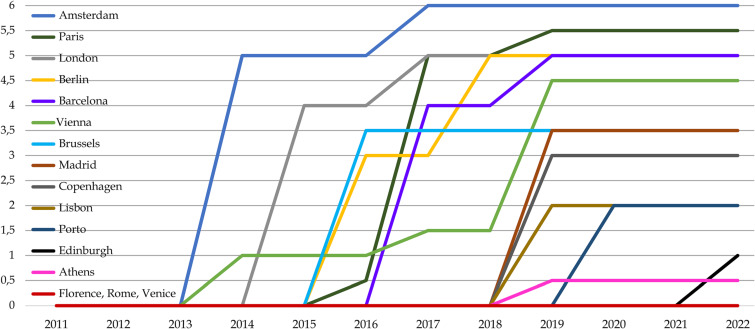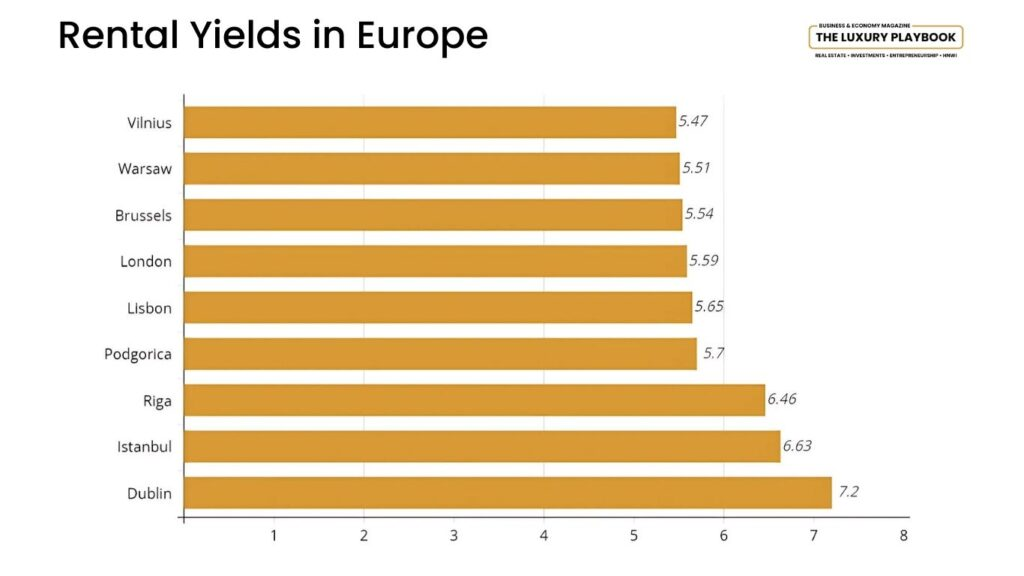Local (European-Specific) Content : Short-term Rentals in Europe
Lesson Learning Objectives:
- Understand how short-term rentals work in Europe by exploring how platforms like Airbnb are used in tourist-heavy cities like Paris, Barcelona, og Rome to generate higher income over shorter rental periods.
- Explore long-term rental strategies, where investors lease properties for six months or more, benefiting from consistent income og reduced management needs in cities like Berlin, London, og Vienna.
- Compare the financial benefits and risks of both strategies, including differences in income stability, seasonality, regulations, og tenant protections, helping learners choose the right approach for their investment goals.
- Analyze tourism and rental yield data, allowing investors to identify high-demand locations and optimize their returns through either short-term or long-term rentals depending on city-specific trends.
11.1 Short-term Rentals in Europe
Short-term rentals refer to renting out properties for brief periods, often to tourists or business travelers. This strategy has become increasingly popular in Europe, particularly in major tourist destinations and cities with high visitor traffic, such as Paris, Barcelona, og Rome. Platforms like Airbnb og Booking.com have made short-term rentals accessible to a wider audience of property owners and investors.
How it Works
Investors purchase or lease properties and rent them out on a short-term basis, typically for a few days to several weeks. In cities like Lisbon og Amsterdam, short-term rentals have seen a surge in demand due to their appeal to tourists who prefer the flexibility and convenience of private homes over hotels.
Key Benefits
- Higher Rental Income: In high-demand tourist cities, short-term rentals can generate significantly higher income compared to traditional long-term rentals. In Paris, for example, short-term rental properties often command premium rates during peak tourist seasons.
- Flexibility: Property owners can choose when to rent out their property and for how long, allowing for personal use or periods of vacancy if necessary.
- Attracting International Guests: Europe’s popularity as a tourist destination ensures a steady stream of international guests, especially in cities like Barcelona og Florence.
Challenges
- Regulations: Many European cities have introduced strict regulations on short-term rentals to combat housing shortages. For example, Berlin og Barcelona have placed caps on the number of days a property can be rented out on platforms like Airbnb.
- Seasonality: Short-term rental income can be highly seasonal, particularly in tourist-heavy cities. During off-peak months, occupancy rates and rental income may decrease significantly.
- Property Management: Managing a short-term rental requires more hands-on involvement, such as cleaning, guest check-ins, and maintenance. Property management services are often necessary, especially for investors who do not live locally.
Figur: Growth in Tourism Over Time for Major European Cities
Beskrivelse:
This graph displays the growth in tourism across several prominent European cities from 2011 to 2022, measured by the increase in tourism or tourism-related infrastructure. Cities such as Amsterdam, Paris, and London show earlier and steady growth trajectories, while others, like Athens and Florence, see significant growth starting in later years. Each city is represented by a distinct color, with lines indicating the year-over-year increase in tourism-related activities or facilities. The trends reflect varying levels of growth among cities, highlighting periods when certain cities experienced a tourism boom.
Viktige takeaways:
- Early leaders: Cities like Amsterdam, Paris, and London started their growth trajectory earlier, maintaining consistent growth over the years.
- Latecomers: Cities such as Athens, Porto, and Florence experienced slower initial growth, with marked increases post-2016.
- Peak growth periods: The data shows key years, such as 2015–2018, when multiple cities experienced a surge in tourism activity.
- Diversity of growth: Not all cities follow a uniform pattern, reflecting unique drivers such as historical significance, policy changes, or marketing strategies.
Application of Information:
Understanding tourism growth trends helps investors and city planners identify which cities are emerging as hotspots and which have plateaued. For real estate investors, the data reveals locations with increasing demand for rental properties and tourism services. Policy-makers can use this data to anticipate infrastructural needs and plan sustainable tourism strategies. Learners in finance and urban development can analyze these trends for broader insights into economic impacts on local markets.
11.2 Long-term Rentals in Europe
Long-term rentals involve leasing properties for extended periods, typically six months or more, to residential tenants. This strategy is widely used in European cities with strong rental demand, such as London, Madrid, og Berlin, where renters often seek stable housing for work or study.
How it Works
Investors lease out properties to tenants on a long-term basis, generating consistent rental income. Long-term rentals provide stability and require less frequent tenant turnover compared to short-term rentals. This strategy works well in cities with high student populations or professional workers, such as Vienna eller Frankfurt.
Key Benefits
- Consistent Income: Long-term rentals provide steady rental income, reducing the uncertainty and volatility that can come with short-term rentals. In cities like Munich og Paris, where rental demand remains high year-round, this strategy ensures stable cash flow.
- Lower Management Costs: Long-term rentals typically require less maintenance and management compared to short-term rentals. Tenant turnover is lower, and responsibilities such as cleaning and guest communication are reduced.
- Tenant Stability: In European cities with strong tenant protections, such as Amsterdam og Copenhagen, long-term leases offer greater stability for both landlords and tenants.
Challenges
- Lower Income Potential: Long-term rentals generally produce lower monthly income than short-term rentals, especially in prime tourist cities. In Rome og Barcelona, landlords may earn less compared to short-term rental strategies.
- Tenant Protection Laws: Many European countries have strict tenant protection laws, making it difficult to evict non-paying or troublesome tenants. Cities like Berlin have strong rental control laws that limit rent increases and provide tenants with extensive rights.
- Rent Control: In cities such as Paris og Madrid, rent control regulations may limit how much landlords can charge, impacting the overall profitability of long-term rental properties.
Figur: Rental Yields in Europe
Beskrivelse:
This bar chart shows the rental yields of various European cities, expressed as percentages, providing insights into the returns investors can expect from rental properties in these locations. Dublin leads with the highest rental yield at 7.2%, followed by Istanbul at 6.63% og Riga at 6.46%. Other cities, such as Podgorica, Lisbon, og London, display yields ranging between 5.5% and 5.7%, indicating stable but comparatively lower returns. The cities at the top represent better opportunities for maximizing rental income relative to property value.
Viktige takeaways:
- Highest Yields: Dublin (7.2%) og Istanbul (6.63%) offer the most attractive rental yields in Europe, making them prime locations for rental property investments.
- Consistent Returns: Cities like Vilnius, Warsaw, og Brussels provide consistent yields, with returns slightly above 5.4%.
- Geographic Diversity: The list showcases a mix of cities from Western Europe (e.g., London, Lisbon) and Eastern Europe (e.g., Riga, Podgorica), highlighting opportunities across different regions.
- Strategic Investments: Investors seeking high rental yields might prioritize markets with favorable yields like Dublin and Istanbul, while balancing risks such as market volatility.
Application of Information:
This data is valuable for real estate investors looking to maximize rental income. By identifying cities with high rental yields, investors can target markets with favorable returns on property investments. Additionally, this information aids in diversifying portfolios geographically and choosing markets based on yield-to-risk assessments. For learners in finance and real estate, this chart demonstrates the importance of analyzing rental yield metrics when making property investment decisions.
Viktig informasjon om leksjoner:
- Short-term rentals offer higher income potential in tourist cities like Paris, Florence, and Lisbon, where properties can be rented at premium rates during peak seasons, especially via platforms like Airbnb and Booking.com.
- Regulations for short-term rentals are strict in cities like Berlin and Barcelona, with limits on the number of rental days and increased scrutiny to prevent housing shortages, making compliance a key factor for investors.
- Long-term rentals provide stability, with consistent monthly income og lower management demands, especially in cities with high student or professional populations like Munich, Vienna, and Copenhagen.
- Tenant protection laws in many European countries—such as in Amsterdam or Berlin—provide security for tenants but can create challenges for landlords, such as restrictions on rent increases and evictions.
- Rental yields vary across Europe, with cities like Dublin (7.2%) og Istanbul (6.63%) offering the highest returns, while more expensive cities may yield less but offer more security or long-term growth potential.
Avsluttende uttalelse:
Choosing between short-term and long-term rental strategies depends on the investor’s goals, local laws, and market conditions. By learning how each approach performs in European cities, you can select the strategy that aligns best with your desired income stream and management style.



